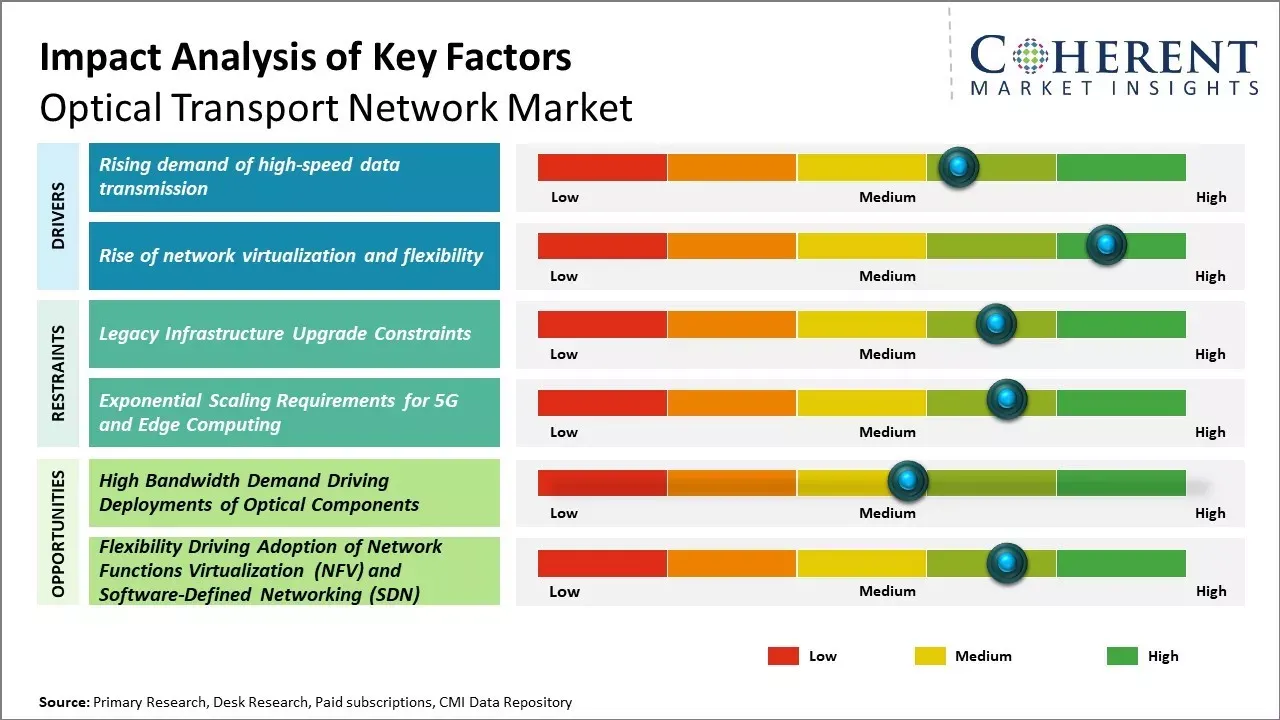The optical transport network market is estimated to be valued at USD 30.56 Bn in 2025 and is expected to reach USD 65.53 Bn by 2032, growing at a compound annual growth rate (CAGR) of 11.5% from 2025 to 2032.

To learn more about this report, Download Free Sample
The demand for optical transport network market is expected to be driven by increasing mobile data traffic and investment in 5G infrastructure. Many telecom operators are upgrading their network infrastructure to accommodate the increasing traffic. This is resulting in the higher deployment of optical transport equipment. Also, the declining prices of smartphones and mobile data tariffs are further enhancing the mobile data consumption. Enhanced mobile broadband with 5G networks will require powerful optical transport capabilities to ensure seamless connectivity and coverage, thereby driving opportunities for optical transport network vendors.
|
Current Event |
Description and its Impact |
|
5G Network Infrastructure Deployment Acceleration |
|
|
Artificial Intelligence and Machine Learning Infrastructure Demands |
|
Uncover macros and micros vetted on 75+ parameters: Get instant access to report
The optical transport network (OTN) market is experiencing a paradigm shift as artificial intelligence becomes integral to managing increasingly complex telecommunications infrastructure. With global data traffic growing exponentially, network operators are turning to AI-driven solutions to optimize performance, reduce operational costs, and enhance service reliability across their fiber-optic networks.
In March 2025, Huawei highlighted the pressing need for operators to build future-ready optical networks to meet growing data demands fueled by AI applications. Kim noted that DeepSeek delivers performance on par with ChatGPT while using only one-sixteenth of the training cost and 1% of the inference cost of other major LLMs. Its launch has significantly lowered entry barriers for SMEs, enabling broader enterprise adoption and what Kim called "limitless development potential."
With the growth of internet and digital connectivity, the demand for high-speed data transmission has increased exponentially over the years. Various new technologies, such as 5G rollout, internet of things (IoT), machine learning/artificial intelligence, autonomous vehicles, etc., are further driving this demand.
High speed data transmission is critical for seamless experience in technologies such as video calling, virtual/augmented reality, streaming high resolution content, and cloud computing. Traditional networks are unable to support such high bandwidth requirements.
Optical transport networks with their ability to carry huge volumes of data at extremely high speeds through fiber optics have become essential infrastructure to support this high-speed digital revolution. They allow internet service providers and telecom operators to scale up their network capacity according to demand surges. Even a slight upgrade in speed from traditional copper networks to optical fiber can improve user experience multifold for technologies dependent on high-speed connectivity.
Various industries have realized the benefits of digitization but lack of high-speed network was a bottleneck. Optical networks help overcome this and accelerate digital transformation. Their advantages over traditional networks have made them preferred medium of network expansion globally to support the insatiable demand for data and connectivity.
Traditionally, telecom networks had rigid silos of infrastructure dedicated for specific services and applications. With the advent of network virtualization technologies, network operators can create virtual networks on top of common optical infrastructure through software defined networks (SDN) and network function virtualization (NFV).
This brings more dynamism, agility, programmability, and cost-efficiency to network management. Optical transport networks have evolved to support network virtualization seamlessly. Their strength lies in carrying huge volumes of data without limiting network virtualization capabilities.
Network virtualization empowers operators to be more responsive to evolving business requirements. They can launch new services at faster pace, split physical networks for dedicated private line use, and customize bandwidth dynamically. Virtual networks also facilitate rapid service provisioning during network outages or surge demands.
Telecom operators are able to extract more value from existing optical assets through virtualization. It allows them to be future-ready for emerging technologies which may require sophisticated virtual networks rather than dedicated infrastructure. This improves long term prospects of optical networks as virtualization becomes increasingly important part of network management. The flexibility and programmability brought by virtualization further consolidates preference for optical transport networks.
For instance, according to the U.S.-China Economic and Security Review Commission, the government spending on smart city initiatives in China reached USD 38.92 billion in 2023. Such advancements in smart cities are expected to drive the demand for optical transfer network solutions.
In terms of technology, WDM is expected to contribute the highest share of 63.0% in 2025, owing to continuous technological advancements in WDM technology. WDM systems have seen significant enhancements over the past few years with the introduction of technologies such as Flexible Grids which allow flexible allocation of bandwidth. This has boosted the capacity and efficiency of WDM networks.
Moreover, the integration of WDM systems with Softwares Defined Networks (SDN) and Network Functions Virtualization (NFV) has optimized resource utilization further. SDN and NFV enable dynamic bandwidth allocation and on-demand provisioning of network services.
Additionally, the emergence of technologies such as Super-Channels and Probabilistic Constellation Shaping (PCS) have extended the optimal transmission reach of WDM systems. This has enabled network operators to realize cost savings from consolidation of cores routers and eliminate unnecessary infrastructure.
Furthermore, advanced modulation formats like 16-QAM and 32-QAM have doubled the optimal transmission reach compared to older modulation techniques like BPSK. These technological enhancements have simplified network architectures and reduced capital expenditures for network operators.
For instance, in August 2025, FS announced the launch of its independently developed FTD Series, an ultra-high-density WDM platform. Such innovations are accelerating the optical transport network market share.
In terms of offerings, component is expected to contribute the highest share of 69.62% in 2025, owing to the critical role of optical components in next-generation networks. Modern networks rely heavily on advanced optical components such as ROADM, Optical Transport, Fiber, Optical Amplifiers, Optical Cross Connects, etc. to maximize throughput, reduce latency, and unify infrastructure. For example, Reconfigurable Optical Add Drop Multiplexers (ROADMs) allow dynamic bandwidth provisioning and optimization of fiber capacity utilization.
Moreover, complex network topologies comprising of ring, mesh and linear architectures depend on sophisticated optical components with high levels of integration. Components such as optical transport systems transmit data over hundreds of kilometers while maintaining signal quality.
Emerging domains like 5G backhaul, metro, and long-haul networks are driving investments in fiber optic infrastructure and advanced components. This is boosting revenues for component manufacturers.
In terms of industry vertical, IT and telecom is expected to contribute the highest share of 44.68% in 2025, as modern telecom networks are largely built on optical fiber infrastructure. With growing reliance on digital technologies, network operators are aggressively deploying next-gen optical transport networks to meet surging bandwidth demand.
Applications like video streaming, IoT, and cloud computing require high speed connectivity between data centers and telecommunication towers. Optical networks provide the necessary backbone for real-time data transmission with greater reliability.
Specifically, 5G rollouts and modernization of 4G networks depend on high-capacity optical transport to deliver ultra-low latency connectivity. Mobile network operators are augmenting metro and long-haul networks to support 5G backhaul requirements.
Additionally, transformational technologies like edge computing require ultra-high bandwidth interconnect between data centers, towers, and edge nodes located in access networks. Optical networks ensure latency sensitive applications meet stringent SLAs. This makes the IT and telecom industry a key customer for optical networking solutions.
For instance, Nokia has launched a wide range of upgrades for its next-generation packet optical transport network (P-OTN) solutions needed by CSPs offering wholesale services.

To learn more about this report, Download Free Sample
North America is expected to dominate the global optical transport network market demand with a market share of 39.2% in 2025. This market dominance is driven by rapid advancements in network infrastructure by major carriers in the U.S.
The region is home to many leading networking vendors and service providers who have heavily invested in upgrading and expanding backbone and metro networks to handle increased bandwidth demand from enterprises, 5G rollouts, and consumer internet traffic.
With the largest telecom industry globally, abundant availability of funding for R&D, and supportive regulatory policies, North America has established itself as the innovation hub for optical network technology development.
In February 2025, FONEX Data Systems Inc. launched the LambdaGain Pluggable Line System, a next-gen optical transport solution offering cost-effective, flexible, and scalable high-capacity transmission for metro and access networks.
The Asia Pacific region, on the other hand, has emerged as the fastest growing market which is expected to exhibit a CAGR of 15.08% in 2025. The growth can be attributed to massive infrastructure investments by carriers to accommodate growing use of smartphones, social media, and OTT apps.
Asia Pacific countries like China and India have the highest number of internet and smartphone users globally, generating explosive data traffic annually. This has compelled regional carriers to enhance network capacities through deployments of advanced wavelength division multiplexing and multiprotocol label switching technologies.
The Asia Pacific region also has a large number of emerging markets undergoing rapid digital transformation and industrialization. Countries like Indonesia, Vietnam, the Philippines, and Thailand have ambitious targets for improving connectivity and boosting internet penetration to support initiatives like smart cities and Industry 4.0.
International bandwidth needs have surged manifold as these nations increase global trade activities and attract more foreign investments requiring seamless data communication. The upcoming 5G rollouts in major Asia Pacific countries will further fuel the requirements for high-speed optical networking in telecom backbones as well as enterprise networks, cementing the region's lead position in the optical network market growth.
For instance, in April 2025, Nokia recently announced to upgrade and expand Vodafone Idea Limited’s (VIL) optical transport network across key metro and circle locations in India.
The China Optical Transport Network (OTN) market is experiencing robust growth, driven by increasing demand for high-speed data transmission, the expansion of 5G networks, and the rise of cloud computing and artificial intelligence (AI).
For instance, in August 2025, China Mobile Zhejiang recently launched its F5G-A 1 ms AI-centric optical network, which will both enable the development of AI services in Zhejiang and stimulate the regional economy.
Japan's Optical Transport Network (OTN) market is experiencing steady growth, driven by the increasing demand for high-speed data transmission, advancements in communication infrastructure, and the adoption of 5G technologies.
For instance, in November 2023, Fujitsu and SoftBank Corp. announced that SoftBank on October 26 completed the nationwide deployment in core areas of an all-optical network in Japan using a disaggregated architecture optical transmission system that supports open networks, including Fujitsu’s next-generation optical transmission platform "1 FINITY Ultra Optical System T900" (hereinafter 1FINITY T900).

To learn more about this report, Download Free Sample
| Report Coverage | Details | ||
|---|---|---|---|
| Base Year: | 2024 | Market Size in 2025: | USD 30.56 Bn |
| Historical Data for: | 2020 To 2024 | Forecast Period: | 2025 To 2032 |
| Forecast Period 2025 to 2032 CAGR: | 11.5% | 2032 Value Projection: | USD 65.53 Bn |
| Geographies covered: |
|
||
| Segments covered: |
|
||
| Companies covered: |
ADTRAN, Inc., ADVA Optical Networking SE, Ciena Corporation, Cisco Systems, Inc., Comtech Telecommunications Corp., Coriant, Ericsson AB, EXFO Inc., Fiberhome Technologies Group Co., Ltd., Fujitsu Limited, Hengtong Groups Co., Ltd., Huawei Technologies Co., Ltd., Infinera Corporation, Iranian Telecommunication Manufacturing Company, NEC Corporation, Nokia Corporation, Shanghai Bell Alcatel Lucent Co., Ltd., and ZTE Corporation |
||
| Growth Drivers: |
|
||
| Restraints & Challenges: |
|
||
Uncover macros and micros vetted on 75+ parameters: Get instant access to report
The need for flexible networks creates an opportunity for network functions virtualization and software-defined networking. Automation and machine learning solutions offer the potential to make networks self-driving.
*Definition: The optical transport network market is a market focused on providing networking infrastructure equipment and services that utilize fiber optic and wavelength division multiplexing (WDM) technologies to transport data, voice, and video traffic over mid-to-long distance networks. The network equipment in this market includes optical transport switches, optical routers, dense wavelength division multiplexers, optical packet switches, and optical line terminals among others.
Share
Share
About Author
Ankur Rai is a Research Consultant with over 5 years of experience in handling consulting and syndicated reports across diverse sectors. He manages consulting and market research projects centered on go-to-market strategy, opportunity analysis, competitive landscape, and market size estimation and forecasting. He also advises clients on identifying and targeting absolute opportunities to penetrate untapped markets.
Missing comfort of reading report in your local language? Find your preferred language :
Transform your Strategy with Exclusive Trending Reports :
Frequently Asked Questions
Joining thousands of companies around the world committed to making the Excellent Business Solutions.
View All Our Clients